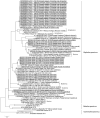Detection of Herpesviruses in Wild Bird Casualties in Slovenia
- PMID: 35280151
- PMCID: PMC8916610
- DOI: 10.3389/fvets.2022.822212
Detection of Herpesviruses in Wild Bird Casualties in Slovenia
Abstract
The complete host range of avian herpesviruses in wild birds is unknown, and information about nucleotide sequences is available only in limited cases. The aim of this study was to detect the presence of herpesviruses in wild birds and to gain more information about their phylogenetic relationship. Oropharyngeal and cloacal swabs from 447 wild birds from 15 different orders presented as wildlife casualties were examined for herpesvirus presence with PCR targeting a fragment of the DNA polymerase gene. Herpesviruses were detected in oropharyngeal and/or cloacal swabs in 34 (7.5%) birds belonging to 11 species from six different avian orders: Accipitriformes, Charadriiformes, Columbiformes, Falconiformes, Passeriformes, and Strigiformes. The results of phylogenetic analysis showed that various herpesviruses sequences are present in the wild bird population. Some herpesviruses are host species-specific, whereas in some cases very similar sequences were detected through different avian orders, which confirms findings that herpesviruses are not always restricted to bird species. It seems that herpesvirus transmission could occur by predation from avian prey, and even by superpredation-for example, large owls, such as the Eurasian eagle owl (Bubo bubo) or Ural owl (Strix uralensis), preying on smaller raptors. This can lead to greater infection exposure and is in line with the fact that raptors were the most infected species group. Nevertheless, the individual or simultaneous detection of herpesviruses in oropharyngeal and cloacal swabs shows that both swab samples should be used for herpesvirus detection in wild birds.
Keywords: Slovenia; avian; herpesvirus; polymerase chain reaction; wildlife.
Copyright © 2022 Žlabravec, Slavec, Vrezec, Kuhar, Zorman Rojs, Golob and Račnik.
Conflict of interest statement
The authors declare that the research was conducted in the absence of any commercial or financial relationships that could be construed as a potential conflict of interest.
Figures

Similar articles
-
Detection and Phylogenetic Analysis of Herpesviruses Detected in Wild Owls in Slovenia.Avian Dis. 2018 Dec 1;62(4):397-403. doi: 10.1637/11899-051418-Reg.1. Avian Dis. 2018. PMID: 31119924
-
Herpesvirus Infection in a Breeding Population of Two Coexisting Strix Owls.Animals (Basel). 2021 Aug 27;11(9):2519. doi: 10.3390/ani11092519. Animals (Basel). 2021. PMID: 34573485 Free PMC article.
-
DETECTION OF HERPESVIRUSES IN PASSERINE BIRDS CAPTURED DURING AUTUMN MIGRATION IN SLOVENIA.J Wildl Dis. 2021 Apr 1;57(2):368-375. doi: 10.7589/JWD-D-20-00032. J Wildl Dis. 2021. PMID: 33626570
-
Inclusion Body Herpesvirus Hepatitis in Captive Falcons in the Middle East: A Review of Clinical and Pathologic Findings.J Avian Med Surg. 2019 Mar 1;33(1):1-6. doi: 10.1647/2018-341. J Avian Med Surg. 2019. PMID: 31124605 Review.
-
[Occurrence of parasites in indigenous birds of prey and owls].Berl Munch Tierarztl Wochenschr. 2002 Jan-Feb;115(1-2):43-52. Berl Munch Tierarztl Wochenschr. 2002. PMID: 11852683 Review. German.
Cited by
-
Editorial: Herpesviruses of animals: recent advances and updates.Front Vet Sci. 2023 Nov 7;10:1326282. doi: 10.3389/fvets.2023.1326282. eCollection 2023. Front Vet Sci. 2023. PMID: 38026625 Free PMC article. No abstract available.
-
Emerging and Novel Viruses in Passerine Birds.Microorganisms. 2023 Sep 20;11(9):2355. doi: 10.3390/microorganisms11092355. Microorganisms. 2023. PMID: 37764199 Free PMC article. Review.
-
Infection due to Buteo buteo herpesvirus in a common buzzard (Buteo buteo insularum).Front Vet Sci. 2023 May 2;10:1152920. doi: 10.3389/fvets.2023.1152920. eCollection 2023. Front Vet Sci. 2023. PMID: 37205226 Free PMC article.
-
Multidecadal High Mortality Disease Events in Australian Domestic Geese Associated with a Novel Alphaherpesvirus, Designated Anatid Alphaherpevirus 2.Transbound Emerg Dis. 2024 Jun 7;2024:3255966. doi: 10.1155/2024/3255966. eCollection 2024. Transbound Emerg Dis. 2024. PMID: 40303083 Free PMC article.
-
Herpesvirus and Subsequent Usutu Virus Infection in a Great Grey Owl (Strix nebulosa) at the Ljubljana Zoo, Slovenia.Animals (Basel). 2024 Apr 17;14(8):1200. doi: 10.3390/ani14081200. Animals (Basel). 2024. PMID: 38672348 Free PMC article.
References
-
- Voelckel K, Bertram E, Gimeno I, Neumann U, Kaleta EF. Evidence for Marek's disease in turkeys in Germany: detection of MDV-1 using the polymerase chain reaction. Acta Virol. (1999) 43:143–7. - PubMed
-
- Kaleta EF, Redmann T. Infectious laryngotracheitis in chickens, peacocks and pheasants and means and limitations for its control with attenuated live virus vaccines. Tierarztl Prax Ausg G. (1997) 25:605–10. - PubMed
LinkOut - more resources
Full Text Sources

